How do I tell which wire is which if I have a copper wire, red and green coded wire? Is the unshielded copper wire ground?
-
1headphones do not have ground, just left, right, and common. – Connor Wolf Nov 14 '10 at 07:05
-
5The common wire is the ground. It also acts as the shield for the other two wires to prevent picking up noise. – Jesse Nov 14 '10 at 07:25
-
4It may be common, but it's still not ground. Also, it has nothing to do with noise pickup. – Connor Wolf Nov 15 '10 at 01:15
-
2The low impedance of the headphones is what is responsible for their general noise-immunity. – Connor Wolf Nov 15 '10 at 01:15
-
1@JesseAC2DE An 'unshielded copper wire' cannot 'act as a shield'. – user207421 Nov 08 '12 at 02:21
-
The ground or shield is used for a return as circuit has to have a full path to opperate. Its is also used to cut down on interference. – Mar 28 '15 at 14:50
-
@EugeneWaugh The OP specifically described it as 'unshielded'. At the voltages required to drive a headphone, interference doesn't begin to be a problem. And unless the 'ground or shield' *does* shield the other two wires it cannot have the effect you mention. – user207421 Mar 28 '15 at 21:56
4 Answers
Red is for Right. Blue (or green) is for Left. Copper is for ground (I remember this with the mnemonic Red Right bLue Left Copper Common). All 3 are coated in a lacquer you need to burn or scrape off before you solder. With standard headphone plugs, with the plug facing away from you, the right pin is right, the center pin is ground, and the left pin is left.
- Common (or "ground")
- Right
- Left
- Insulating ring

- 1,193
- 9
- 21
-
I have a green, red, copper, and then a red/green striped one. What is the red/green striped? – Vigrond Nov 25 '13 at 23:47
-
3Is this TRRS rather than TRS? It might be for the second ring/mic connection. Best way is to burn off the laquer and test it with a multimeter. – Journeyman Geek Nov 26 '13 at 00:02
-
Great answer, easy and complete, great image, great mnemonic (I won't have any more to figure it out trying all the options) and the best of all...I didn't Know that the coating can be burned! This is the end of broken wires while trying to scrape them! – Carlos Robles Jul 10 '14 at 00:14
-
I'd suggest a microtorch for this - its a little hand torch that uses a cigarette lighter for a fuel source, but it much hotter and cleaner. – Journeyman Geek Jul 10 '14 at 02:40
-
I've replaced connectors on a lot of different headphones over the years. What I have found is that there is no standard for wire colors. They are all different.
Consumer headphones, professional headphones, intercom headsets: they are all different.
The proper way to check to see which wire does what function is to measure it.
Put the headphones on and do a continuity check between each of the wires. Listen for the "tick" that comes out as you touch each wire.
Common to left hot: tick comes from left speaker. Common to right hot: tick comes from right speaker. Left hot to right hot: tick comes from both speakers.
If you are using a multimeter on the low-ohms range, you will see that the left-hot to right-hot resistance is about double that from the common wire to either the left or right speakers.
Bottom line: don't rely on wire colors. Test it and ensure that you get it right the first time.
- 23,390
- 2
- 35
- 67
There is a general "R Code" for audio equipment. R: Red, Right, Ring, Recieve. When you have a TRS connector (Tip/Ring/Shield) the Ring always goes to the Right channel on a L/R system, the Receive on a Send/Receive system. The Left/Send/Tip doesn't have a standard. Black used to be the common color, now it's white, sometimes it's blue. It doesn't matter because you use the R as the identifier. The bare wire is the shield, though it doesn't provide much shielding or grounding, it's purpose is to create the flow loop for discarded electrons. But since few know anything about that part of the system it is referred to as shielding, grounding, common, but it's all irrelevant.
- 61
- 1
- 1
It's probably the case, check resistances between the wires with a DVM to make sure. Listening to the noise made will tell you which is connected to right or left.
- 38,774
- 2
- 60
- 96